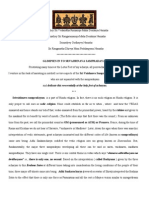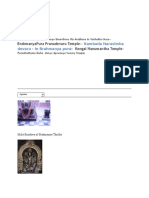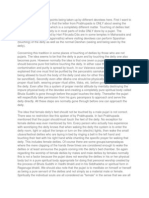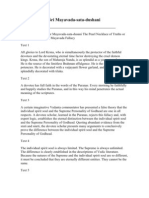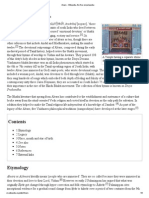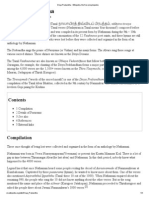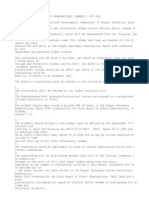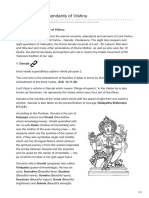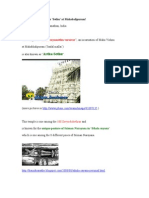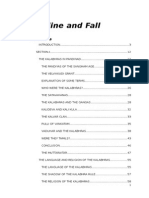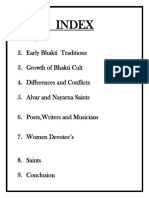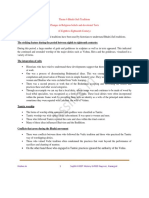Periyalvar
Periyalvar
Uploaded by
Murali KrishnanCopyright:
Available Formats
Periyalvar
Periyalvar
Uploaded by
Murali KrishnanOriginal Description:
Copyright
Available Formats
Share this document
Did you find this document useful?
Is this content inappropriate?
Copyright:
Available Formats
Periyalvar
Periyalvar
Uploaded by
Murali KrishnanCopyright:
Available Formats
1/22/2014
Periyalvar - Wikipedia, the free encyclopedia
Periyalvar
From Wikipedia, the free encyclopedia
Periyalwar or Periazhwar (3055 BC) is one of the twelve azhwar saints of South India, who are known for their affiliation to Vaishnava tradition of Hinduism. Vishnucitta or Periyalwar incarnated on this earth in the 47th year after the beginning of the Kali Era (3102 BC).[3] The verses of azhwars are compiled as Nalayira Divya Prabandham and the 108 temples revered are classified as Divya desam. According to some accounts, Periyazhwar is considered the first in the line of the twelve azhwars, while other accounts place him as the eighth. His original name is Vishnuchittar and he since he is considered the oldest among azhwars, he is called Periazhwar.
Periyalvar
Born Vishnuchittar 3055 BC[1][2] Srivilliputhur Unknown
Died
Titles/honours Alvar saint Philosophy Literary works Vaishnava Bhakti Tirupallandu, Periya Azhwar thirumozhi
Related to his birth, the traditional scriptures mention that Goda Devi or Andal, the daughter of Vishnuchittar incarnated on this earth in the 98th year after the beginning of the Kali Era (3102 BC).[4] [5]As per Hindu legend, Periyazhwar was the foster father of Andal, the only female azhwars.The works of Periyazhwar contributed to the philosophical and theological ideas of Vaishnavism. His contributions are Thirupallandu and Periya Azhwar thirumozhi among the 4000 stanzas in the Nalayira Divya Prabandam. In South-Indian Vishnu temples, Periyazhwar has images and festivals associated with him. The Garudasevai festival in Srivilliputhur temple, where five Vishnu temples in the region participate, is an event dedicated to him. The verses of Periyazhwar and other azhwars are recited as a part of daily prayers and during festive occasions in most Vishnu temples in South India.
Contents
1 Azhwars 2 Early life 3 Andal 4 Works 5 Culture 6 Notes 7 References
Azhwars
The word azhwar means the one who dives deep into the ocean of the countless attributes of god. Azhwars are considered the twelve supreme devotees of Vishnu, who were instrumental in popularising Vaishnavism. The religious works of these saints in Tamil, songs of love and devotion, are compiled as Nalayira Divya Prabandham containing 4000 verses and the 108 temples revered in their songs are classified as Divya desam.[6][7] The saints
http://en.wikipedia.org/wiki/Periyalvar 1/5
1/22/2014
Periyalvar - Wikipedia, the free encyclopedia
had different origins and belonged to different castes. As per tradition, the first three azhwars, Poigai, Bhutha and Pey were born miraculously. Tirumizhisai was the son of a sage, Thondaradi, Mathurakavi, Peria and Andal were from brahmin community, Kulasekhara from Kshatria community, Namm was from a cultivator family, Tirupana from panar community and Tirumangai from kazhwar community. Divya Suri Saritra by Garuda-Vahana Pandita (11th century AD), Guruparamparaprabavam by Pinbaragiya Perumal Jiyar, Periya tiru mudi adaivu by Anbillai Kandadiappan, Yatindra Pranava Prabavam by Pillai Lokacharya, commentaries on Divya Prabandam, Guru Parampara (lineage of Gurus) texts, temple records and inscriptions give a detailed account of the azhwars and their works. According to these texts, the saints were considered incarnations of some form of Vishnu. Poigai is considered an incarnation of Panchajanya (Krishna's conch), Bhoothath of Kaumodakee (Vishnu's Mace/Club), Pey of Nandaka (Vishnu's sword), Thirumalisai of Sudarshanam (Vishnu's Image of Rangamannar-Andal discus), Namm of Vishvaksena (Vishnu's commander), Madhurakavi of temple in Srivilliputhur Vainatheya (Vishnu's eagle, Garuda), Kulasekhara of Kaustubha (Vishnu's necklace), Periy of Garuda (Vishnu's eagle), Andal of Bhoodevi (Vishnu's wife, Lakshmi, in her form as Bhudevi), Thondaradippodi of Vanamaalai (Vishnu's garland), Thiruppaan of Srivatsa (An auspicious mark on Vishnu's chest) and Thirumangai of Saranga (Rama's bow). The songs of Prabandam are regularly sung in all the Vishnu temples of South India daily and also during festivals.[7][8]
Early life
Periyalvar was born into a Brahmin family in Srivilliputhur, near Madurai and was named Vishnuchittar meaning "one who has Vishnu in his mind". Legend says he rejected the vedic philosophical debates of his upbringing to focus on Bhakti (devotion), especially on doing simple tasks for god. He would make garlands of flowers for the deity of the temple. Once the Pandyan king Vallabhadevan had a competition between scholars to find out the path to paramapada. Vishnuchittar won the competition by explaining that the path to moksha is by service to Vishnu. He quoted various historic and Vedic reference to prove his point. The king was satisfied and he honored Vishnuchittar by taking him around the streets of Madurai. It is believed that Koodal Azhagar, the presiding deity in the Koodal Azhagar Temple near Madurai witnessed the event with his consort. Periyalvar was surprised and he immediately composed Thirupallandu, the first twelve verses of Naliyara Divya Prabandam.[9]
Andal
As per Hindu legend, Andal is believed to have been discovered under a Tulsi(Basil) plant in the temple garden of Srivilliputtur, by Vishnuchittar. The childless Vishnuchittar was happy about the child and named her Kodhai. The child was brought up by Vishnuchittar in an atmosphere of love and devotion. Vishnuchittar doted on her in every respect, singing songs to her about Vishnu, teaching her all the stories and philosophy he knew and sharing with her his love for Tamil poetry. As Kodhai grew into a maiden, her love and devotion for Ranganatha (the reclining form of Vishnu) grew to the extent that she decided to marry none but the Ranganatha himself. As days progressed, her resolve strengthened and she started to live in a dream world with her beloved and was constantly fantasizing about marrying him. Vishnuchittar had the responsibility of delivering flower garlands to the Ranganathar temple everyday. Kodhai made these garlands and eventually started wearing the flower garland which was meant to be offered to the deity. This is generally considered sacrilege in Hinduism. However, Kodhai felt she should test to see how the garland suited her and only if it did, she should offer it to the deity. One day, she was caught red-handed by her father in this strange act, and being an orthodox devotee, he was extremely upset. He rebuked her and told her not to repeat the sacrilegious act in the future. Frightened and apologetic, Kodhai made a new garland for the offering
http://en.wikipedia.org/wiki/Periyalvar 2/5
1/22/2014
Periyalvar - Wikipedia, the free encyclopedia
that day. Legend says that that very night Vishnu appeared to Vishnuchittar in his dream and asked him why he had discarded Kodhai's garland instead of offering it to him. Vishnuchittar was moved and understood the divine love of his daughter. From that day on, Kodhai is believed to obtained the name "Andal", the girl who "ruled" over the Lord. She is also known by a phrase Soodi kodutha Sudarkodi which means "The bright creeper-like woman who gave her garlands after wearing them". As Andal grew to a marriageable age, Vishnuchittar prepared to get her married to a suitable groom. Andal, however, was stubborn and insisted that she would marry only the god Ranganathar. The father was worried, but Lord appeared in Vishnuchittar's dream and informed him that he would marry Andal at Srirangam. He commanded the priests at Srirangam, in their dreams, to prepare for the wedding. Andal who was anxious to reach Srirangam was unable to control herself in her urgency to meet her beloved. She ran into the sanctum sanctorum of Ranganatha and is believed to have merged with him.[10][11][12][13]
Works
Image of Andal decorated with jewels and garland, with her life pictures describing her various stage in life in the background
Vishnuchittar composed a couplet called "pallandu"( ) (also called Thirup-Palandu( ) out of respect) translating to "Long live for many years, Long live for many years for Hundreds of thousands of years!" to God. This is a very important prayer in Srivaishnava liturgy today. Vishnuchittar composed some pasurams in the 4000 Divya Prabhandham called Perialvar Tirumozhi where he explores a devotee's love for God through the metaphor of Yashoda's motherly love for Krishna. He was the adopted father of Kodhai or Andal, the only woman alvar. Periyalwar was fascinated by the childhood exploits of Lord Krishna and developed devotion and love for God, incarnated as Krishna. And he sang of Krishna, the Child Deity, with maternal love. He was more concerned about the welfare of child Krishna than his own. Because of his love and devotion, he was named Perialwar or great azhwar.[14] Apart from his native Srivilliputhur, he visited Thirukoshtiyur, Sri Ranganathaswamy Temple, Srirangam, Tiruvellarai and Azhagar Kovil.
Culture
The devotees of Srivaishnva sect of Hinduism pay respect to the azhwars in a similar vein to their worship of Vishnu. The verses of azhwars are recited as a part of daily prayers and during festive occasions in most Vishnu temples in South India. There are shrines dedicated to the azhwars in most of the Vishnu temples in South India.[15] The Periyazhwar Mangalasasanam festival (also called Aani Utsavam) is celebrated every year during the Tamil month of Aadi (July - August) in the Vadapadrasayi temple in Srivilliputhur. The image of Periyazhwar receives each of the five Vishnu images for Mangalasasanam. Vadapatrasayee Periya Perumal, festival image of Srivilliputhur Divyadesam, Sundararaja Perumal of Kaatazhagar Temple, Srinivasa Perumal of Tiruvannamalai and Thiru Thangal Appan are received by Periyazhwar with different verses from Nalayira Divya Prabandam. In the evening, Garuda Sevai festival is celebrated where all of the festival deities are carried around the streets of Srivilliputhur.[9]
Notes
1. ^ L. Annapoorna (2000). Music and temples, a ritualistic approach (http://books.google.com/books? id=Yj8UAQAAIAAJ). p. 23. ISBN 9788175740907.
http://en.wikipedia.org/wiki/Periyalvar 3/5
1/22/2014
Periyalvar - Wikipedia, the free encyclopedia
2. ^ Sakkottai Krishnaswami Aiyangar (1911). Ancient India: Collected Essays on the Literary and Political History of Southern India (http://books.google.com/books?id=htArUg0OMpcC). p. 403-404. ISBN 9788120618503. 3. ^ M. Srinivasachariar (1974). History of Classical Sanskrit Literature: Being an Elaborate Account of All Branches of Classical Sanskrit Literature, with Full Epigraphical and Archaeological Notes and References, an Introduction Dealing with Language, Philology, and Chronology, and Index of Authors & Works (http://books.google.com/books?id=4dVRvVyHaiQC&pg=PA278). Motilal Banarsidass Publishe. pp. 278. ISBN 978-81-208-0284-1. 4. ^ K. K. Nair (1 September 2007). Sages Through Ages - Volume IV: India's Heritage (http://books.google.com/books?id=-AMWIzs7uzsC). AuthorHouse. ISBN 978-1-4670-6410-1. 5. ^ "Andal's Life" (http://creative.sulekha.com/aandaal_264169_blog). 6. ^ Rao, P.V.L. Narasimha (2008). Kanchipuram Land of Legends, Saints & Temples (http://books.google.co.in/books? id=GTMTQLuCNSMC&pg=PA27&dq=poigai+azhwar&hl=en&sa=X&ei=kBxzUf2hD6ah2gX4uYGgDQ&ved=0C DMQ6AEwAA#v=onepage&q=poigai%20azhwar&f=false). New Delhi: Readworthy Publications (P) Ltd. p. 27. ISBN 978-93-5018-104-1. 7. ^ a b Dalal 2011, pp. 20-21 8. ^ Ramaswamy, Vijaya (2007). Historical Dictionary of the Tamils (http://books.google.co.in/books? id=H4q0DHGMcjEC&pg=PA14&dq=poygai&hl=en&sa=X&ei=mdR1UfhOePR0wH1u4DYAw&ved=0CFAQ6AEwBjge#v=onepage&q=poygai&f=false). Scarecrow Press. p. 211. ISBN 9780810864450. 9. ^ a b S., Prabhu (26 July 2012). "Garuda accorded special status here" (http://www.thehindu.com/features/fridayreview/religion/garuda-accorded-special-status-here/article3686242.ece). The Hindu. Retrieved 2013-07-07. 10. ^ Svm, Ghanananda; Stewart-Wallace, John (1973). Women Saints of East and West (http://books.google.co.in/books? id=6IhLSGtuW_EC&pg=PA27&dq=Women+Saints+of+East+and+West+%2B+andal&hl=en&sa=X&ei=tBpzUfrD DZDM9gTpyYGYAg&ved=0CC8Q6AEwAA#v=onepage&q=Women%20Saints%20of%20East%20and%20West %20%2B%20andal&f=false). Vedanta Press. pp. 2427. ISBN 9780874810363. 11. ^ Roy, Sumita (1996). M. Sivaramkrishna, ed. Poet Saints Of India (http://books.google.com/books? id=zMvlDsnEgRoC&pg=PA201&dq=periazhwar&hl=en&sa=X&ei=xcjpUfHUAYuK9gSumoHYBQ&ved=0CDYQ6 AEwAQ#v=onepage&q=periazhwar&f=false). Sterling Publishers Pvt. Ltd. p. 199-201. ISBN 9788120718838. 12. ^ S., Manickavasagam (2009). Power of Passion (http://books.google.com/books?id=Rla0s4OrvYC&pg=PA163&dq=periazhwar&hl=en&sa=X&ei=xcjpUfHUAYuK9gSumoHYBQ&ved=0CDwQ6AEwA g#v=onepage&q=periazhwar&f=false). Strategic Book Publishing. p. 163. ISBN 9781608605613. 13. ^ Chattopadhyaya, Brajadulal (2009). A Social History Of Early India (http://books.google.co.in/books? id=0tX4wzIUY3QC&pg=PA242&dq=periyazhwar&hl=en&sa=X&ei=Z_XqUZCUAYn29gS2oYDgDg&ved=0CD4 Q6AEwAw#v=onepage&q=periyazhwar&f=false). Delhi,India: Pearson Education India. p. 242. ISBN 9788131719589. 14. ^ V.K., Subramanian (2006). 101 Mystics of India (http://books.google.co.in/books? id=Zso41H6D9MAC&pg=PA49&dq=Azhwar&lr=&as_brr=3#PPA49,M1). Abhinav Publications. ISBN 978-817017-471-4. 15. ^ Ul Hassan, Syed Siraj (1920). The Castes and Tribes of H.E.H. the Nizam's Dominions, Volume 1 (http://books.google.co.in/books?id=lYSd3yL9h0C&pg=PA130&dq=tirupan+azhwar&hl=en&sa=X&ei=ZlfsUcXxM4io9gSz7YHoBQ&ved=0CC8Q6AEwAA #v=onepage&q=tirupan%20azhwar&f=false). Asian Educational Services. pp. 130131. ISBN 9788120604889.
References
B. S., Chandrababu; S., Ganeshram; C., Bhavani (2011). History of People and Their Environs (http://books.google.co.in/books? id=crxUQR_qBXYC&pg=PA47&dq=poygai&hl=en&sa=X&ei=50R0UaefIZGy9gSDt4DoCA&ved=0C C8Q6AEwADgU#v=onepage&q=poygai&f=false). Bharathi Puthakalayam. ISBN 9789380325910.
http://en.wikipedia.org/wiki/Periyalvar 4/5
1/22/2014
Periyalvar - Wikipedia, the free encyclopedia
Chari, S. M. Srinivasa (1997). Philosophy and Theistic Mysticism of the l vrs (http://books.google.co.in/books?id=8TwHhuZrZwC&pg=PA16&dq=poygai&hl=en&sa=X&ei=JTZ0UY6UEoqC8ATkloHgDA&ved=0CDAQ6AEwAA# v=onepage&q=poygai&f=false). Motilal Banarsidass Publishers. ISBN 9788120813427. Dalal, Roshen (2011). Hinduism: An Alphabetical Guide (http://books.google.co.in/books? id=DH0vmD8ghdMC&pg=PA308&dq=poigai&hl=en&sa=X&ei=ozhzUYPiC4Ga9gT74YGYBQ&ved=0 CDMQ6AEwAA#v=onepage&q=poigai&f=false). Penguin Books India. ISBN 9780143414216. Das, Sisir Kumar; Shitya Akdem (2005). A history of Indian literature, 500-1399: from courtly to the popular (http://books.google.co.in/books? id=BC3l1AbPM8sC&pg=PA29&dq=madhurakavi+azhwar&hl=en&sa=X&ei=WcviUarJC7LC4AOX0o CYDg&ved=0CDYQ6AEwAQ#v=onepage&q=madhurakavi%20azhwar&f=false). chennai: Shitya Akdem. ISBN 81-260-2171-3. Ramanujan, Attipat Krishnaswami (2005). Hymns for the Drowning: Poems for Vishnu (http://books.google.com/books?id=9pa7h0jhB0C&printsec=frontcover&dq=nammalvar&hl=en&sa=X&ei=u3TVUaHG47Y8gSW94DIDA&ved=0CDAQ6AEwAA). Penguin Books. ISBN 9780144000104. Govindchrya, Akoavilli (1902). The Holy Lives of the Azhvrs: Or, the Drvida Saints (http://books.google.co.in/books?id=SoTe_qTyIKIC&dq=periyazhvar&source=gbs_navlinks_s). Mysore: G. T. A. Press. Retrieved from "http://en.wikipedia.org/w/index.php?title=Periyalvar&oldid=591664769" Categories: Alvars Hindu religious figures This page was last modified on 21 January 2014 at 03:48. Text is available under the Creative Commons Attribution-ShareAlike License; additional terms may apply. By using this site, you agree to the Terms of Use and Privacy Policy. Wikipedia is a registered trademark of the Wikimedia Foundation, Inc., a non-profit organization.
http://en.wikipedia.org/wiki/Periyalvar
5/5
You might also like
- Anyone Who Has Taken Birth As A Human Being In India Bharata-BhumiFrom EverandAnyone Who Has Taken Birth As A Human Being In India Bharata-BhumiNo ratings yet
- Srivaishnava Guru Paramparai - ThaniyansDocument32 pagesSrivaishnava Guru Paramparai - Thaniyansromesh10008No ratings yet
- Tirukacchi Nambi VaibhavamDocument17 pagesTirukacchi Nambi Vaibhavamarunagirinathar100% (1)
- Microsoft Word - Glimpses Into Srivaishnava SampradDocument20 pagesMicrosoft Word - Glimpses Into Srivaishnava Sampradapi-3814866100% (1)
- Naanmukan ThiruvandhadhiDocument134 pagesNaanmukan Thiruvandhadhiraj100% (1)
- Periya ThiruvandhadhiDocument119 pagesPeriya Thiruvandhadhisrishti_21100% (1)
- ThirupalliyezhichchiDocument47 pagesThirupalliyezhichchiNarayan Gowri SankerNo ratings yet
- Hanuma Bhima Madhva 2Document61 pagesHanuma Bhima Madhva 2sanjay100% (12)
- Sri Narasimha Darshanam 103-Singa Perumal KoilDocument6 pagesSri Narasimha Darshanam 103-Singa Perumal KoilSudarsanan NesamonyNo ratings yet
- 108 KrishnaDocument15 pages108 KrishnaJuan VillegasNo ratings yet
- Dhere R - Vitthal of PandharpurDocument299 pagesDhere R - Vitthal of PandharpurArunoday Majumder100% (1)
- Main Slokas With MeaningDocument114 pagesMain Slokas With MeaningRD100% (1)
- Tiru MalaDocument29 pagesTiru MalaCook Thomas100% (1)
- AbburDocument23 pagesAbburPrahalad Karnam100% (2)
- Madhwacharya ' S Lineage - "GURU CHARITE"Document136 pagesMadhwacharya ' S Lineage - "GURU CHARITE"Srivatsa100% (4)
- Thirumangai AzhwAr's ThirukkurunthANdakamDocument28 pagesThirumangai AzhwAr's ThirukkurunthANdakamsvprskNo ratings yet
- Narasimha DevaruDocument9 pagesNarasimha DevaruAnil Suha0% (1)
- Kanchi Acharya Lineage PDFDocument13 pagesKanchi Acharya Lineage PDFPavan ModukuruNo ratings yet
- Sriraghunatha and Sripadaraja Final Part1Document39 pagesSriraghunatha and Sripadaraja Final Part1Sebastian CarterNo ratings yet
- Apourusheyatvam of The Vedas (Sri VTVN)Document41 pagesApourusheyatvam of The Vedas (Sri VTVN)RyanSavioRodriguesNo ratings yet
- GD011 - Swami Desika DarsanamDocument88 pagesGD011 - Swami Desika DarsanamPankajashree Raghu100% (2)
- Sharada Prarthana Eng v1Document1 pageSharada Prarthana Eng v1purinaresh85100% (1)
- Facebook On Radhas FeetDocument5 pagesFacebook On Radhas FeetGaura KeshavaNo ratings yet
- Mur T I Puja MantrasDocument3 pagesMur T I Puja MantrasAbhishek banikNo ratings yet
- Narayana Teer ThaDocument13 pagesNarayana Teer ThaAnonymous 4rMVkArNo ratings yet
- Niksheba RakshaDocument41 pagesNiksheba RakshaAzhvan Dasan50% (2)
- HH 45 Villivalam Srimadh Azhagiya Singar VaibhavamDocument19 pagesHH 45 Villivalam Srimadh Azhagiya Singar VaibhavamSarvam SrikrishnarpanamNo ratings yet
- Divya Desam, List ofDocument13 pagesDivya Desam, List ofarasanabcNo ratings yet
- Sri Ranganatha Swamy Temple - SrirangamDocument65 pagesSri Ranganatha Swamy Temple - SrirangamchandanyatradasNo ratings yet
- Sri Ananta Padmanabha Swamy Temple TrivandrumDocument41 pagesSri Ananta Padmanabha Swamy Temple Trivandrumchandanyatradas100% (1)
- Scriptural Sources: Sanskrit Tamil Avatar VishnuDocument14 pagesScriptural Sources: Sanskrit Tamil Avatar VishnunieotyagiNo ratings yet
- Yatra Yatra Raghunatha KirtanamDocument4 pagesYatra Yatra Raghunatha Kirtanamanon-782185100% (1)
- Sri Tattva Muktavali or Sri Mayavada Sata DusaniDocument26 pagesSri Tattva Muktavali or Sri Mayavada Sata DusaniRadha K das100% (1)
- AlwargalDocument2 pagesAlwargalAnonymous WtjVcZCgNo ratings yet
- Sri Adikeshava Temple at ThiruvattarDocument53 pagesSri Adikeshava Temple at ThiruvattarchandanyatradasNo ratings yet
- Book Catalouge of Sri K R Krishna SwamiDocument17 pagesBook Catalouge of Sri K R Krishna Swamiapi-3836332No ratings yet
- Tirumala Tirupati Devasthanams, Tirupati Sri Balaji Arogya Varaprasadini SchemeDocument49 pagesTirumala Tirupati Devasthanams, Tirupati Sri Balaji Arogya Varaprasadini Schemevamsi100% (1)
- Yajur Veda Avani Avittam or Upakarma and Gayathri Japam-2012Document203 pagesYajur Veda Avani Avittam or Upakarma and Gayathri Japam-2012Premkumar NagendranNo ratings yet
- Bhagavad Gita Quick BookDocument21 pagesBhagavad Gita Quick BookManiappan RNo ratings yet
- Divya DesamsDocument8 pagesDivya DesamstechzonesNo ratings yet
- Sri Satyanarayna Katha PDFDocument6 pagesSri Satyanarayna Katha PDFgsrnarayan0% (1)
- NarasimhaDocument11 pagesNarasimhadaitya99No ratings yet
- Ebook 05 irAmAnusa nooTTrandAdiDocument56 pagesEbook 05 irAmAnusa nooTTrandAdiSrinivasa Narayanan VNo ratings yet
- Bhagavadgita Study GuideDocument48 pagesBhagavadgita Study GuidesgganeshinNo ratings yet
- Swami Ayyappan The Reality and The Asianet MythDocument7 pagesSwami Ayyappan The Reality and The Asianet MythchamundihariNo ratings yet
- Thiruppavai Pasurams 26-30Document14 pagesThiruppavai Pasurams 26-30RajeshNo ratings yet
- Periazhwar VannamAdangalDocument6 pagesPeriazhwar VannamAdangalraj100% (2)
- AgamaDocument24 pagesAgamarameshmudigere100% (6)
- Ramayanam Part 1Document31 pagesRamayanam Part 1RedSea AssocNo ratings yet
- Bhakta Prahallada: God Emerged as Man-Lion from the Pillar as Narasimha AvatarFrom EverandBhakta Prahallada: God Emerged as Man-Lion from the Pillar as Narasimha AvatarNo ratings yet
- The Birth of the War-God A Poem by KalidasaFrom EverandThe Birth of the War-God A Poem by KalidasaNo ratings yet
- Story of Ravana and the Epic War of Lanka Told in Slow MotionFrom EverandStory of Ravana and the Epic War of Lanka Told in Slow MotionNo ratings yet
- Thiruppavai Goda's Gita - Volume 4: Thiruppavai - Goda's Gita, #4From EverandThiruppavai Goda's Gita - Volume 4: Thiruppavai - Goda's Gita, #4No ratings yet
- Saints and Non-Saints Their Distinguishing Characters and QualitiesFrom EverandSaints and Non-Saints Their Distinguishing Characters and QualitiesNo ratings yet
- Mahabaleshwar Temple, Gokarna - WikipediaDocument5 pagesMahabaleshwar Temple, Gokarna - WikipediaMurali KrishnanNo ratings yet
- SambandarDocument4 pagesSambandarMurali KrishnanNo ratings yet
- SundararDocument12 pagesSundararMurali Krishnan100% (1)
- TirunavukkarasarDocument6 pagesTirunavukkarasarMurali KrishnanNo ratings yet
- SmritiDocument4 pagesSmritiMurali Krishnan100% (1)
- Smarta TraditionDocument13 pagesSmarta TraditionMurali KrishnanNo ratings yet
- VaishnavismDocument9 pagesVaishnavismMurali KrishnanNo ratings yet
- AlvarsDocument6 pagesAlvarsMurali Krishnan100% (1)
- Divya PrabandhaDocument4 pagesDivya PrabandhaMurali Krishnan100% (2)
- Project Title: Environmental Impact of Mining Activity On Land Use: A Case Study of Udaipur Mineral BasinDocument3 pagesProject Title: Environmental Impact of Mining Activity On Land Use: A Case Study of Udaipur Mineral BasinMurali KrishnanNo ratings yet
- Central Sector Scholarship SchemeDocument14 pagesCentral Sector Scholarship SchemeMurali KrishnanNo ratings yet
- NayanmarDocument4 pagesNayanmarMurali KrishnanNo ratings yet
- Bhakti MovementsDocument39 pagesBhakti Movementsmulpuru1104No ratings yet
- Bhakti MovementDocument6 pagesBhakti MovementMaharshi BharaliNo ratings yet
- Consorts and Attendants of VishnuDocument11 pagesConsorts and Attendants of VishnudharmagyanNo ratings yet
- 51 Tamil Devotional Poetry VishnuDocument8 pages51 Tamil Devotional Poetry VishnuStuart LittleNo ratings yet
- Bhakti Movement and Sufi Movement PPTDocument43 pagesBhakti Movement and Sufi Movement PPTRaj KumarNo ratings yet
- Sufi and Bhakti Movements Ias 2021-1-11Document8 pagesSufi and Bhakti Movements Ias 2021-1-11neeraja bhanotNo ratings yet
- Alwar HistoryDocument10 pagesAlwar HistorysgganeshinNo ratings yet
- Sri Vishnava Guru ParamparaDocument140 pagesSri Vishnava Guru ParamparaR NNo ratings yet
- The Parasurama Myth - Prof MM NinanDocument5 pagesThe Parasurama Myth - Prof MM NinanBharat ShahNo ratings yet
- Divya Desam - WikipediaDocument28 pagesDivya Desam - WikipediaKishore SanjayNo ratings yet
- BVN-SSTDocument3 pagesBVN-SSTtitir100% (1)
- Bhakti and SufismDocument6 pagesBhakti and SufismAarnaNo ratings yet
- Tamil StudiesDocument460 pagesTamil StudiesSharmalan Thevar75% (4)
- Srivaishnavism Intresting FactsDocument12 pagesSrivaishnavism Intresting Factsraj100% (3)
- Antiquity of Bhagavatam (MA Thesis Summary) PDFDocument26 pagesAntiquity of Bhagavatam (MA Thesis Summary) PDFDaniel OpazoNo ratings yet
- Thirupaan AzhwarDocument6 pagesThirupaan AzhwarBusinessNo ratings yet
- History Worksheet 7Document4 pagesHistory Worksheet 7gahlotvansh11No ratings yet
- Kadal Mallai - Another 'Sethu' at Mahabalipuram!Document8 pagesKadal Mallai - Another 'Sethu' at Mahabalipuram!Jayasree SaranathanNo ratings yet
- Periya ThiruvandhadhiDocument119 pagesPeriya Thiruvandhadhisrishti_21100% (1)
- 12 Chapter 8Document45 pages12 Chapter 8Arnaud DidierjeanNo ratings yet
- Part-II: CHAPTER 2 Bhakti Sufi Traditions Class 12 Notes History Key Concepts in NutshellDocument12 pagesPart-II: CHAPTER 2 Bhakti Sufi Traditions Class 12 Notes History Key Concepts in NutshellGaurangi OberoiNo ratings yet
- Hist7 - 8 - Devotional Paths To The Divine PDFDocument18 pagesHist7 - 8 - Devotional Paths To The Divine PDFRavi GarcharNo ratings yet
- 07 Social Science Histroy Key Notes ch08 Devotional Paths To The DivineDocument2 pages07 Social Science Histroy Key Notes ch08 Devotional Paths To The DivineDIGI-TECH SOLUTIONSNo ratings yet
- Kalabharas Part1Document83 pagesKalabharas Part1Ravi SoniNo ratings yet
- The Bhakti MovementDocument46 pagesThe Bhakti MovementVishal Singh Rana100% (1)
- Bakthi and Sufi MovementDocument32 pagesBakthi and Sufi MovementVivek AnandhanNo ratings yet
- XII History Theme 6 Bhakti HssliveDocument9 pagesXII History Theme 6 Bhakti HssliveTanisha SaxenaNo ratings yet
- Devotional Paths To The DivineDocument29 pagesDevotional Paths To The DivineAnanya SomaniNo ratings yet
- Bhakti Sufi TraditionsDocument56 pagesBhakti Sufi TraditionsJenni ParkNo ratings yet





